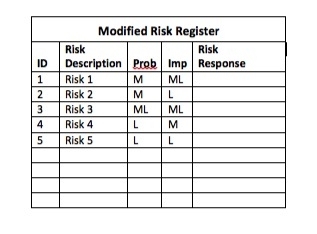 The biotech and pharmaceutical industries are no stranger to risk - organizing clinical trials for medications that may never reach the open market due to inefficiency can place a significant financial burden on companies. When it comes to managing them, identifying procedures can be essential to avoiding or minimizing the financial impact of risks.
The biotech and pharmaceutical industries are no stranger to risk - organizing clinical trials for medications that may never reach the open market due to inefficiency can place a significant financial burden on companies. When it comes to managing them, identifying procedures can be essential to avoiding or minimizing the financial impact of risks.The Economist Intelligence Unit conducted a survey of senior management executives in the pharmaceuticals and life sciences industry regarding risk in their respective companies. The 65 responses were combined with those of an earlier survey of 353 executives in a wider range of other industries. It mainly focused on North America, with 65 percent of respondents hailing from the region, but also included international areas such as Europe, Asia-Pacific, Africa and Latin America.
Management is C-Level
According to its findings, the EIU reported that the ultimate responsibility of risk management was falling on CEOs, CFOs, CROs and general counsel. The survey found that the senior executives could be doing a better job of defining the company's interest in risk, ensuring that information gets to the appropriate people for assessment.
Most Time Spent on Compliance
Following controls and monitoring, compliance takes up most of their time with risk management. However, this leaves managers and executives with less freedom to watch for emerging threats that could create financial hardships. As a result, companies are failing to spread risk awareness throughout their organizations.
Mismatch Between Barriers, Risk Processes
The results showed that two-thirds of respondents had no intention of recruiting a chief risk officer, with less than one-third saying their organization has one on staff already. While breaking down the risk management silo may have been beneficial, the lack of awareness diminishes an organization's ability to understand new risks.
The Benefit of Third-Party Training
According to the U.S. Food and Drug Administration, quality systems are becoming integral to the pharmaceutical industry. In turn, risk management is a valuable component of an effective quality system.
The biotech and pharmaceutical industries can greatly benefit from outsourcing their risk management training to third-party experts. Merit Career Development offers courses specific in project risk management for the biotechnology and pharmaceutical industries. For more information, click here.
The EIU study underscores the advantages that extra training can bring to risk management in the pharmaceutical industry. With a healthy roster of subject matter experts, Merit can help executives not only manage current threads but also look ahead to potential emerging risks.
 Our project management courses have been updated to align with the 6th edition of the Project Management Body of Knowledge (PMBOK®) guide. Every course description in the catalog includes a listing of the number of credits by organization. See inset for example of accreditations per course.
Our project management courses have been updated to align with the 6th edition of the Project Management Body of Knowledge (PMBOK®) guide. Every course description in the catalog includes a listing of the number of credits by organization. See inset for example of accreditations per course. Previously, we wrote about how resolving conflict often has the side benefit of building a cooperative bond — even loyalty — between the factions. As each side gains a deeper understanding of the others’ viewpoints, respect builds and morale improves. Cooperative, low stress interactions, create a fertile environment for productive brainstorming, ultimately boosting the health of your organization.
Previously, we wrote about how resolving conflict often has the side benefit of building a cooperative bond — even loyalty — between the factions. As each side gains a deeper understanding of the others’ viewpoints, respect builds and morale improves. Cooperative, low stress interactions, create a fertile environment for productive brainstorming, ultimately boosting the health of your organization. In Part 3 of this series, we’ll examine the five conflict styles that help people understand their own responses as well as diffuse conflict with others. Specifically, we’ll look at the five conflict styles that Kenneth W. Thomas and Ralph H. Kilmann identified and can be assessed in the Thomas-Kilmann Conflict Mode Instrument (TKI), a globally accepted, widely used diagnostic assessment for resolving conflict.
In Part 3 of this series, we’ll examine the five conflict styles that help people understand their own responses as well as diffuse conflict with others. Specifically, we’ll look at the five conflict styles that Kenneth W. Thomas and Ralph H. Kilmann identified and can be assessed in the Thomas-Kilmann Conflict Mode Instrument (TKI), a globally accepted, widely used diagnostic assessment for resolving conflict. Standard risk responses include Avoidance, Mitigation, Transference, and Acceptance (passive/active). At Merit, we developed a reporting process that would show that the risk factors were decreasing as the project progressed. Supplemented with suitable risk responses, the true reduction of risk probability occurs over time.
Standard risk responses include Avoidance, Mitigation, Transference, and Acceptance (passive/active). At Merit, we developed a reporting process that would show that the risk factors were decreasing as the project progressed. Supplemented with suitable risk responses, the true reduction of risk probability occurs over time. The Probability and Impact Matrix is one of the tools that we recommend in a risk management strategy. It is superimposed with risks that are labeled or numbered as in the above example. “Red” area risks were uniquely documented on a trending month-to-month basis such that it could be seen “driving” toward zero.
The Probability and Impact Matrix is one of the tools that we recommend in a risk management strategy. It is superimposed with risks that are labeled or numbered as in the above example. “Red” area risks were uniquely documented on a trending month-to-month basis such that it could be seen “driving” toward zero. Project managers can set themselves up for failure by not properly planning for risk. Overly optimistic proposals run over budget, past deadlines and through resources if there isn’t a comprehensive plan for mitigating and responding to expected risk.
Project managers can set themselves up for failure by not properly planning for risk. Overly optimistic proposals run over budget, past deadlines and through resources if there isn’t a comprehensive plan for mitigating and responding to expected risk. May 2014
May 2014